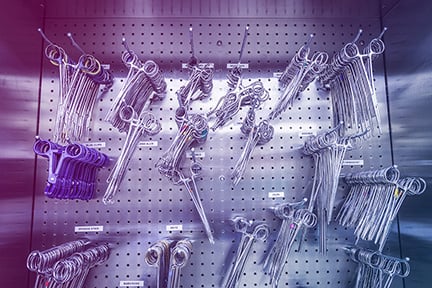Surgical site infections are responsible for 75% of deaths associated with surgical sites, according to the Centers for Disease Control and Prevention (CDC). They also account for a fifth of all healthcare-associated infections (HAIs) and increase hospital stays by an average of more than nine days.
For these reasons and more, infection prevention during surgeries has become an increasing priority, as health care systems and facilities are held to stricter regulatory compliance standards than ever before. Surgical infection prevention begins with the instruments used during surgery, which must be sterile for the safety of patients.
As reusable medical devices continue to become more complex, tracking surgical instruments has also become a bigger feat. Many of these instruments require regular inspections and maintenance, and their intricate designs have led to new sterilization processes and technologies.
Despite these changes, many sterile processing departments still track their instruments using paper and pen, leaving them susceptible to problems such as legibility, human error, time-consuming recalls, and boxes of archives. These challenges can be avoided by implementing surgical instrument tracking software, which offers patients superior care while giving hospital administrators peace of mind that their processes are compliant.
Here, we’ll take a look into the unrivaled benefits of surgical instrument tracking systems and why it’s imperative that hospitals implement them sooner rather than later.
Benefits of surgical instrument tracking systems for hospitals
Surgical instruments need to be tracked back to the cases for which they were used, both for effective infection control and legal purposes. If a patient develops an infection following surgery, the hospital will need to provide evidence that each instrument and set went through the appropriate sterilization processes. Hunting down paper forms can be a daunting (or potentially impossible) task.
Surgical instrument tracking software for hospitals places them in direct control of their surgical inventory down to the instrument level. Individual instruments are tracked through the entire reprocessing cycle, from decontamination, assembly, sterilization, and storage, directly to surgical cases. These tracking systems save time, improve interdepartmental communication, and provide tools to ensure no steps are missed during sterilization.
Operational efficiency
Surgical instrument tracking systems can save time for sterile processing technicians and even surgical staff. These technologies give facilities a faster, more efficient, way to locate instruments, address recalls, and access reporting, which can often be retrieved instantly. They also allow sterile processing departments (SPD) to review operating room staff schedules to stay up to date on future instrument needs for upcoming cases. This enables SPD teams to prioritize instruments that are needed for more urgent or imminent surgeries.
Accuracy
With on-demand reporting, surgical instrument tracking software provides hospitals with an accurate historical account that shows exactly which instruments and containers were used in a procedure. This eliminates the unintentional omission of steps by sterile processing technicians who are tracking the process manually and reduces the possibility of incorrect information being recorded.
Increased visibility
Both sterile processing technicians and OR teams can check the status of each case cart and container in real time. This two-way visibility helps OR teams better manage their case schedule and opens a line of communication with sterile processing departments. Both parties can offer kudos or flag mishaps directly within the system. SPDs can also keep an eye on instruments and containers that haven’t been returned.
Improved patient care
Because SPD teams are in the loop on upcoming OR needs, surgical instrument tracking software can help ensure cases start on time to prevent surgical delays, which saves valuable time and money. It can also help reduce the risk of HAIs by assuring a smooth and safe patient experience.
Guidance for technicians
Surgical instrument tracking software provides the user with specific instructions for use (IFU) information, training tips, pictures, and acceptable instrument substitutes. This guidance can be especially helpful for new technicians-in-training by allowing them to be more independent.
Ease of integration
It may take some time for new instrument tracking systems to be adopted by SPD technicians, but the technical integration is straightforward. The best tracking systems are built to be directly integrated into a hospital’s existing ecosystem and are compatible with interfaces for OR scheduling, washers, sterilizers, biological incubators, automatic endoscope reprocessors, and more.
Manage accountability in the sterile processing department
Surgical instrument tracking software comes with many benefits for hospitals, but among the most important is enhanced accountability. Compliance standards and surveys are becoming more detailed and scrutinizing, making it imperative that facilities keep meticulous tabs on surgical supplies.
Surgical instrument tracking systems provide undeniable proof that reprocessing steps have been completed properly and validated. They prevent mistakes by alerting technicians when a step is missed and bar them from moving forward until that step is completed. They hold facilities accountable to regulatory and compliance standards by providing instant feedback when processes aren’t compliant. They also allow for better self-auditing and staff accountability.
In today’s digital world, surgical instrument tracking software is essential for facilities to ensure patient safety and adherence to regulatory policies. CensiTrac was the first software specifically designed to make surgical instrument tracking more efficient, helping to lower implementation costs, reduce mistakes, and keep sterilization processes under tight control. Learn more about the industry’s most capable and comprehensive surgical inventory management system or request a demo to see it in action.


